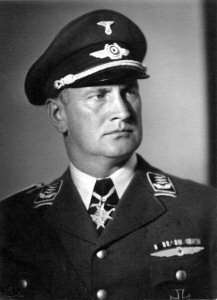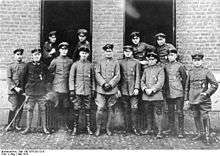Bruno Loerzer
| Bruno Loerzer | |
|---|---|
 | |
| Born |
22 January 1891 Berlin |
| Died |
23 August 1960 (aged 69) Hamburg |
| Allegiance |
|
| Service/branch |
|
| Years of service | 1911–20, 1935–45 |
| Rank | Generaloberst |
| Battles/wars |
World War II |
| Awards |
House Order of Hohenzollern Pour le Mérite Knight's Cross of the Iron Cross |
Bruno Loerzer (22 January 1891 – 23 August 1960) was an officer in the German Luftstreitkräfte during World War I and Luftwaffe during World War II.
Career

Born in Berlin, Loerzer was a prewar army officer who learned to fly in 1914. Hermann Göring flew as Loerzer's observer from 28 October 1914 until late June 1915. Transferring to fighters, Loerzer flew with two Jagdstaffeln in 1916 before joining Jagdstaffel 26 in January 1917. By then he had scored two victories over French aircraft. His tally reached 20 victories at the end of October and he received the Pour le Mérite in February 1918.
The same month, he took command of the newly formed Jagdgeschwader III, the third of Germany's famed "flying circuses." His aces included his brother Fritz, who claimed 11 victories. Leading Jasta 26 and three other squadrons, with Hermann Dahlmann's support as adjutant and wingman, Loerzer proved a successful wing commander. Equipped with the new BMW-engined Fokker D.VII, JG III cut a wide swath through Allied formations in the summer of 1918, and his own score mounted steadily. He achieved his last ten victories in September when he reached his final score of 44 victories. Shortly before the armistice, he was promoted to Hauptmann (captain).
Loerzer irregularly fought with Freikorps anti-communist paramilitary units from December 1918 until March 1920, helping to create an atmosphere of chaos and lawlessness in Germany. He commanded FA 427 in the Baltic area, supporting the Eiserne Division in the tactical air role. During the 1930s he was a leader in various civil aviation organizations (National Socialist Flying Corps: NSFK), and rejoined the Luftwaffe in 1935 with the rank of Oberst (colonel).
Loerzer benefited from his long friendship with Göring, becoming Inspector of Fighters with rank of major general in 1938. During the early war years he was commander of II Air Corps, being awarded the Knight's Cross of the Iron Cross in May 1940. His II Air Corps participated in the invasion of Russia in the summer of 1941, as a section of Kesselring's 2nd Air Fleet—in support of Fieldmarshall von Bock. His unit was transferred to Messina, Sicily in October 1941, and he remained there until the middle of 1943, when his section returned to the Italian mainland.
Göring promoted Loerzer to Generaloberst in February 1943 and in June 1944 was chief of the National Socialist Leadership Branch of the Luftwaffe. He retired in April 1945. Loerzer died in 1960, at the age of 69.
Awards and decorations
- Iron Cross (1914)
- 2nd Class
- 1st Class
- Knight's Cross Second Class of the Order of the Zähringer Lion with Swords
- Knight's Cross of the Royal House Order of Hohenzollern with Swords
- Pour le Mérite on 12 February 1918 as Oberleutnant and leader of Jagdstaffel 26
- Cross of Honor
- Sudetenland Medal with Prague Castle Bar
- Iron Cross (1939)
- 2nd Class
- 1st Class
- Pilot/Observer Badge in Gold with Diamonds
- Knight's Cross of the Iron Cross on 29 May 1940 as Generalleutnant and commanding general of the II. Fliegerkorps[1][2]
- Mentioned in the Wehrmachtbericht (7 August 1941)
References
Citations
Bibliography
- Fellgiebel, Walther-Peer (2000) [1986]. Die Träger des Ritterkreuzes des Eisernen Kreuzes 1939–1945 — Die Inhaber der höchsten Auszeichnung des Zweiten Weltkrieges aller Wehrmachtteile [The Bearers of the Knight's Cross of the Iron Cross 1939–1945 — The Owners of the Highest Award of the Second World War of all Wehrmacht Branches] (in German). Friedberg, Germany: Podzun-Pallas. ISBN 978-3-7909-0284-6.
- Scherzer, Veit (2007). Die Ritterkreuzträger 1939–1945 Die Inhaber des Ritterkreuzes des Eisernen Kreuzes 1939 von Heer, Luftwaffe, Kriegsmarine, Waffen-SS, Volkssturm sowie mit Deutschland verbündeter Streitkräfte nach den Unterlagen des Bundesarchives [The Knight's Cross Bearers 1939–1945 The Holders of the Knight's Cross of the Iron Cross 1939 by Army, Air Force, Navy, Waffen-SS, Volkssturm and Allied Forces with Germany According to the Documents of the Federal Archives] (in German). Jena, Germany: Scherzers Militaer-Verlag. ISBN 978-3-938845-17-2.
- Norman Franks et al. (1993). Above the Lines: A Complete Record of the Fighter Aces of the German *Air Service, Naval Air Service, and Flanders Marine Corps 1914-1918. Grub Street, London.
- Anthony Kemp (1982, 1990 reprint). German Commanders of World War II. Osprey Pub., London.
- Die Wehrmachtberichte 1939–1945 Band 1, 1. September 1939 bis 31. Dezember 1941 [The Wehrmacht Reports 1939–1945 Volume 1, 1 September 1939 to 31 December 1941] (in German). München, Germany: Deutscher Taschenbuch Verlag GmbH & Co. KG. 1985. ISBN 978-3-423-05944-2.
External links
- theaerodrome.com
- geocities.com at the Wayback Machine (archived October 29, 2009)
| Military offices | ||
|---|---|---|
| Preceded by none |
Commander of Jagdgeschwader 53 Pik As March, 1937 – March, 1938 |
Succeeded by Oberstleutnant Werner Junck |
| Preceded by none |
Inspekteur der Jagdflieger 1 April 1938 – 31 January 1939 |
Succeeded by Oberst Werner Junck |
| Preceded by General Wilhelm Wimmer |
Commander of 2. Flieger-Division (1938-1939) 1 February 1939 – 11 October 1939 |
Succeeded by II. Fliegerkorps |
| Preceded by 2. Flieger-Division |
Commander of II. Fliegerkorps 11 October 1939 – 23 February 1943 |
Succeeded by Generalleutnant Martin Harlinghausen |